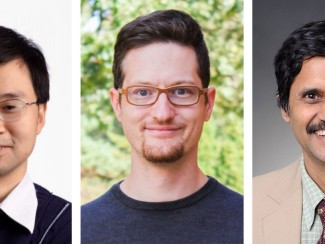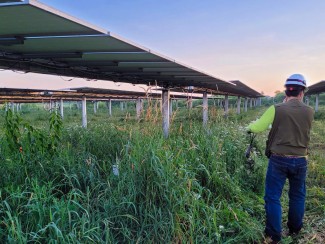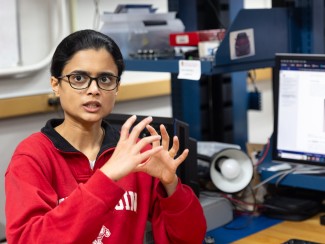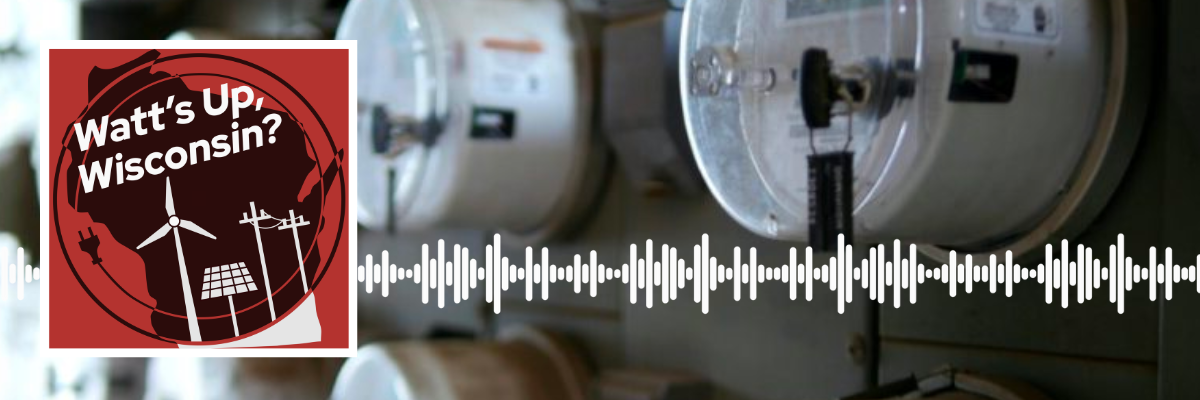
Every time we flip a switch, it's connected to an energy bill. But, the impact of that energy bill isn't the same for everyone. For many Americans, they experience unaffordable energy bills and undue energy burden–spending a greater portion of their income on energy bills than the average household.
In this episode, we look at energy justice and ways we can make energy equitable for all. We speak to Jaime Garibay Rodriguez about his research into carbon lock-in and the barriers to adopting cleaner, and cheaper, energy technologies. Then, we turn to Slipstream, a Madison-based organization working to accelerate clean energy adoption with an equity lens.
Do you have a question about energy in Wisconsin? Ask the Wisconsin Energy Institute at communications@energy.wisc.edu or tweet us and tag #WattsUpWI.
Listen to Watt's Up, Wisconsin? on Apple podcasts, Spotify podcasts, Google Podcasts, Youtube, or anywhere you find podcasts.
Guests
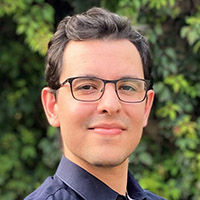 Jaime Garibay Rodriguez, Postdoctoral Research Assistant in Professor Morgan Edwards’ Climate Action Lab at the UW-Madison La Follette School of Public Affairs
Jaime Garibay Rodriguez, Postdoctoral Research Assistant in Professor Morgan Edwards’ Climate Action Lab at the UW-Madison La Follette School of Public Affairs
Jaime's research focuses on understanding the pathways for transitioning to sustainable energy usage in building heating and cooling, in-campus and beyond, in collaboration with the Office of Sustainability. He has a background in Chemical Engineering.
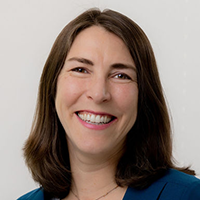 Jeannette LeZaks, Director of Research and Innovation at Slipstream
Jeannette LeZaks, Director of Research and Innovation at Slipstream
Jeannette's work at Slipstream focuses on applied and technical research examining how people use energy, and hopes that this knowledge will serve to advance energy efficiency and sustainability. Jeannette has a Master's degree focusing on Energy Analysis and Policy from the Nelson Institute of Environmental Studies at UW-Madison.
Credits
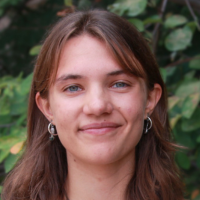 Britta Wellenstein, Host
Britta Wellenstein, Host
Britta is a Wisconsin Energy Institute communications intern and UW–Madison undergraduate majoring in Life Sciences Communication and Environmental Studies.
This episode was produced by Britta Wellenstein and Michelle Chung.
Theme music by Eden Comer.
Transcript
Britta Wellenstein: When you walk into a room, you often flip a switch.
[light switch sound]
Usually out of habit, but it's more than just light. The energy that powers that lightbulb is tangled in a web of other systems, both mechanical systems and the sources of energy we've discussed, but also unequal social systems. That flip of a switch is ultimately tied to you and your utility bill.
But for many Americans, they experience unaffordable energy bills, an undue burden just to turn on the lights in their house. As the energy landscape continues to change to cleaner energy sources, we need to ensure these changes are equitable and don't create injustice.
[soft guitar music fades in]
Today on Watt’s Up, Wisconsin, we're looking at energy, justice, understanding how energy disproportionately impacts people and ways we can make it equitable for all.
[light switches on]
Britta Wellenstein: You're listening to Watt’s Up Wisconsin, brought to you by the Wisconsin Energy Institute, where we explore your questions on energy in Wisconsin.
[cow moo]
I'm communications intern Britta Wellenstein. Energy justice is a wide term. The Initiative for Energy Justice defines it as the goal of achieving equity both in the social and economic participation of the energy system, while also remediating social, economic, and health burdens on those disproportionately harmed by the energy system.
To understand this definition a bit more, I spoke to Jaime Garibay Rodriguez, a postdoctoral researcher at the University of Wisconsin La Follette School of Public Affairs. Jaime works in Morgan Edwards’ Climate Action Lab and with the Office of Sustainability on UW–Madison's campus.
Jaime Garibay Rodriguez: It really refers to the equitable distribution of benefits and burdens of energy production, distribution, and consumption and what really energy justice encompasses are the socioeconomic and environmental dimensions of energy systems. And really, its purpose is to ensure fairness, inclusivity, and sustainability of energy related activities.
And this really has to happen from the decision making process. So really, really from the start, and it also has to end with the outcomes stemming from that process. So it's really important to take that into account. And the reason why energy justice is a hot topic right now is because we know that energy has a vital influence on the overall well-being of society. And this just to name a few, it's like enabling access to essential services, positive health outcomes, environmental benefits, and, of course, economic opportunities.
There are a few key principles of energy justice, and it's about distributional, procedural, recognition, intergenerational and also environmental justice. And the last two are highly interrelated.
Britta Wellenstein: Before we can dive into energy justice, we have to look at why we need it and understand the unequal distributions of energy and energy burden.
Britta Wellenstein: In your definition of energy justice, you said this idea of burden. So what is energy justice trying to fix? What is this inequality that we're seeing?
Jaime Garibay Rodriguez: Yeah, so I think one of the main issues around energy justice, access to affordable energy. And one way to measure these is with energy burden. So in general, energy burden is a portion of household income that is spent on energy bills and transportation fuel. So it's the overall energy expenditure of our household, and it's simply calculated by dividing the household energy expenditure by the total income, and it's commonly expressed as a percentage. So this varies with every other definition of energy burden, but it's usually accepted that a household that spends more than 6% of its income on energy expenditures is energy burdened.
However, there are significant differences in energy burdens across regions and communities. This is due to several factors, mainly because of energy prices and income levels, obviously, but also the geographical location. So this is particularly important because there could be a situation where there's a household with very low income located in an area with extreme weather, like very cold climate or very hot weather, that will need increased heating and cooling needs.
So I think that it's really important that we understand energy burden and that a higher energy burden will put a household at increased risk of something called energy poverty. This this is especially important when there's a shock in the system and shocks in the systems are usually volatility in energy prices and extreme weather events. What's important about understanding what is the energy burden in a region is that at this point household would not be able to afford adequate energy services and may need to compromise to meet other basic needs such as food or health care.
Britta Wellenstein: Energy burden is felt strongly in Wisconsin. For low income communities, the average energy burden is 6% and 14% for extremely low income households In Wisconsin, this burden can be worse in specific communities. A Sierra Club report found that in Milwaukee, low income communities overall spent 12.8% of their income on utilities. As Jaime said, 6% or higher is considered unaffordable.
A 2016 American Council for Energy Efficient Economy report found that on average, low income households spend 25% more per square foot for energy. Low income communities aren't the only ones that experience a higher burden. The same study found that African-American households experience a median energy burden 64% greater than white households, and Latino households have a median burden 24% greater.
This burden comes into play as we start to electrify neighborhoods. As neighborhoods start to add renewable energy or change out gas heaters for electric, which often reduce energy costs in the future, some communities will experience carbon lock-in, which is a big area of Jaime's research.
Britta Wellenstein: And we're in this kind of change in energy going to renewables, and there's something that you've researched called carbon lock-in. As for a changing to renewables, and we want these like safer forms of energy, both for the climate and for and for health. So kind of what is carbon lock-in and what's outside of energy justice?
Jaime Garibay Rodriguez: Carbon lock-in refers to this tendency of carbon intensive technologies to persist over time. So the problem is that this persistence will lock out low carbon energy alternatives due to mainly economic factors. But there are some technical factors and societal factors that take place, even political factors. Thinking about this economic aspect of carbon lock-in.
One reason it occurs is that there are significant investments already being made to continue the use of these technologies, so these investments where we have a sort of inertia, they they could be also promoted by political or societal expectations.
One very important thing to note about carbon lock-in is that this could happen even if there are alternatives of low carbon technologies that could be better in economic terms or technical terms, like when we know that we could install like a solar panel and it's going to be cheaper than a carbon-intensive technology, but we don't do it for some reason. So it's really, I think is one of the bigger challenges to overcome if we want to achieve ambitious climate goals. And there have been some efforts to assess this implications of carbon lock-in, but it's still, I think, sort of a conundrum faced by policymakers because of the near-term economics of green energy and political barriers. So it's it's a big issue.
There are currently investments being made into these carbon intensive technologies. And one example of that is that there are some natural gas utilities that have leak prone distribution pipelines, because these pipelines emit methane, which is pretty bad, and they are trying to fix that. But instead of investing money into low carbon technologies, they are putting a lot of this morning through replacing these old pipelines, and this could increase further the problem of energy burden for some communities and basically lock them into carbon in the future.
Britta Wellenstein: When utility companies continue to invest in fossil fuels rather than renewables, it locks in communities. Avoiding new fossil fuel infrastructure is one goal of Wisconsin Governor's Task Force on Climate Change Goals, directly stating that avoiding fossil fuel infrastructure is one way to prevent carbon lock-in. Jaime researches heat pump adoption and carbon lock-in. Heat pumps are a more sustainable and often more energy efficient way to heat your home than a furnace.
Jaime Garibay Rodriguez: So we are trying to assess the inequities of heat pump adoption in the US. So we have found that communities of color in particular and minorities and low income communities and really vulnerable groups are less likely to adopt a heat pump in comparison to a white community or higher income communities.
What's more important about that is that we have found that that is happening in regions where there are clear economic advantages of installing these heat pumps, so I think that's a clear example of an energy injustice because so we're in a way, but there's a sort of mechanism that's happening that even when there's a region like it's very favorable to install these technologies, a person of color is much, much less likely to adopt these technologies than another person. It's a really complex issue to address.
But what's important about these is that we know that this is happening. This is something that is clearly observed. Then where are the policy implications or what could be like policy programs that could be implemented to target those communities and to make sure that those communities are prioritized in the transition?
Britta Wellenstein: This disproportionate adoption of heat pumps is reflected across other renewable energy practices like rooftop solar. There are many reasons why this trend exists, which are often called adoption barriers to not only heat pumps but other renewable technologies. Income is one barrier, but there are others as well, like lack of awareness of incentive programs, distrust in adopting new technologies, or a lack of infrastructure.
Because of these barriers, communities are still locked-in to carbon. And this is not to mention the disproportionate health impacts lower income and communities of color face by being locked into carbon. If these communities are left behind as we start electrifying homes and buildings, they can experience even more burden in the utility death spiral.
Jaime Garibay Rodriguez: We're trying to answer where the energy burden implications of communities that are most vulnerable to experiencing this carbon lock-in. So a particular case that we are analyzing is related to the phase out of natural gas in favor of building electrification for heating in communities.
So one potential scenario in the future is that as there are more ambitious goals or there are more incentives to swap out like a natural gas furnace, for instance, people will start doing that and we'll start buying heat pumps, and when this becomes more and more prevalent, the natural gas prices for remaining customers will start to increase. And then that will create a situation when there's more motivation to switch a natural gas furnace to heat pump, and that will increase further and further the prices of natural gas, until eventually a utility will cannot be able to sustain itself, and this is usually called the utility death spiral.
Britta Wellenstein: To reiterate this, as communities, buildings and homes start electrifying, adding solar panels or transitioning away from gas stoves, they're not as reliant on utility companies for energy, and this decreases the utility companies space. But other communities who cannot make these changes, often low income, are left with higher energy bills as utility companies try to make up the difference, which is why when we start to electrify communities, we need to ensure all communities are getting equal access to these technologies, and there are a lot of ideas on how to prevent the utility death spiral and prevent undo energy burden.
Jaime Garibay Rodriguez: A very good example of a type of solution is improving energy efficiency in homes, like in cold climates. Of course, this is a well-known concept, but even like in Wisconsin, there are estimates that about 18% of energy could be saved in single family homes through energy efficiency measures alone. And there could be regions where this is a little bit more increased because higher energy expenditure is higher and higher, so there's more concern about energy efficiency of homes. But still, like I think 18% for for Wisconsin is pretty high.
Addressing this energy efficiency problems not only will improve the quality of life and comfort of people in their homes, it's also going to lower their energy bills and it's really not that difficult to do. This could be promoted by increasing incentives for energy efficient appliances and weatherization, and retrofitting homes
Another solution to an energy burden that I think more people are familiar with is simply increasing the percentage of renewable energy. So wind and solar are thought to play a major role in reducing energy burdens, because I think we are at the point where they could contribute to lower overall energy cost. So that's a really important one.
Another example, just mention a few others, could be like direct financial assistance to low income households. And also an increasingly important problem is that we need to increase like energy education. So a lot of people of low income don't have access to like literacy or energy education. Community engagement with those communities most vulnerable could be a great opportunity to let them know that they can save money through just like energy efficiency measures.
Britta Wellenstein: Then what do you think the future of energy justice holds? Kind of. Where do you see the next direction?
Jaime Garibay Rodriguez: So first of all, I think I'm hopeful, hopeful for the future, mainly because of the political setting right now in the US, I think is really exciting where things are going, like talking about that a central goal in the energy transition is equity and justice.
So a clear example of that is this commitment to Justice40 goals. This means that there's federal commitment that at least 40% of these federal investments into the new energy systems will go to these advantaged communities, and I think that's pretty huge. Like 40% is a big number. Maybe you have heard about Dr. Tony Reames. He's the US deputy Director for Energy Justice in the Department of Energy, and he has pointed out that it's really about reimagining a system that has created these injustices for for many, many years. But he's hopeful that at some point, addressing equity issues will be just a standard way to do business, whether it's a new investment or just an expansion of our business.
So I think putting that in front of everything that's in the decision making process of a new business is super exciting and should give everyone hope of the future. And just to come back to me what this energy justice future looks like. So I think it's where everyone can benefit from the energy system and it's affordable and it's environmentally sustainable, empowers community, creates jobs, it's resilient.
Well, I think a more ambitious goal is to have not only energy justice in the US, but have an injustice in across the world where international cooperation can help developing countries to achieve this. I think that's the ultimate goal.
[music fades in]
Britta Wellenstein: In our talks on solutions working towards energy justice, Jaime pointed me to Slipstream, a nonprofit based in Madison, Wisconsin, aiming to accelerate clean energy adoption with an equity lens. To learn more about their work and ways they're impacting both Wisconsinites and people throughout the nation, I spoke to Jeannette LeZaks, the director of research and innovation at Slipstream.
Jeannette LeZaks: So Slipstream is a nonprofit. We are a mission driven organization with a mission to accelerate climate solutions for everyone. And the way we do that is largely through research, which is the group that I'm part of, program implementation, and financing. We also do a lot of education and training towards building professionals. We've been an organization that's been around in some form or another for I think, around three decades.
We have roots in Wisconsin. We have offices in Madison. We also have an office in Chicago, but we do work across the country now.
Britta Wellenstein: What are some of the programs that Slipstream has to drive energy equity and make it easier for people to not face these burdens?
Jeannette LeZaks: When I think about energy justice, I also think about how it's tied to housing justice. When, you know, Slipstream certainly is thinking about this a lot. Our roots are in building science and understanding kind of the built environment. You know, you can't really talk about energy justice without talking about the house that you live in. So oftentimes you see people paying way too much for their energy in comparison to their household income. Their energy burden, that proportion of cost that they pay for energy to how much money they make can be disproportionately high for some people. The reasons for that may not just be their income, it may be the houses that they live in, and so that's what we try to tackle on a day to day basis, is trying to figure out ways to reduce that energy burden.
So a lot of what we do increases the efficiency of a home or business, and we hope that that drives a reduction in energy costs over time.
Britta Wellenstein: Slipstream focuses much of the research and efforts on building efficiency to decrease energy cost by weatherizing homes. Weatherization means protecting the interior of a home from outdoor elements, particularly to increase energy efficiency.
Jeannette LeZaks: We have just started a program with Ramsey County that is looking at critical repairs to manufactured homes. So manufactured homes represent and affordable housing alternatives to those that can't own maybe stick built homes, and it's an affordable option for a lot of people. A lot of times with weatherization or any kind of energy efficiency program, a house needs repairs before you can even start taking on some of the energy issues.
So they have mold issues, they have indoor air quality issues, roof is falling apart, things that are not necessarily energy related, but you really can't make the upgrades that you want to the energy systems without addressing some of these really basic repairs. For that program, we are working to actually work through some of those critical repairs so that the weatherization can happen for those manufactured homes.
We also have an affordable housing new construction program. One of the programs that we've been doing in the Chicago area, and that one is for new construction. So kind of moving away from manufactured homes, both for new construction buildings. We're working with affordable housing developers on making sure that the buildings that they built include energy efficiency measures, affordable housing.
Also, it means that the operational costs, the energy costs that a person pays when they live in these buildings has to be low enough. Again, what we're talking about energy burdens that month and month cost is really critical to reduce that overall energy burden for somebody that may not have that much flexibility in their income.
Britta Wellenstein: Slipstream also works to provide financial assistance to families looking to install renewable technology. As we discussed with Jaime, these technologies often have a higher upfront cost, creating an adoption barrier Slipstream works to decrease.
Jeannette LeZaks: This barrier causes front and center when people are talking about their energy bills, and so when you talk about investing in your home, making it more efficient, even though we know that that's going to have some operational savings and oftentimes, like a lot of operational savings or your monthly bill goes down that upfront cost is a major deterrent from getting anything done.
Even even some of the incentives that are provided through utility programs that pay for a portion of a higher efficiency piece of equipment, you still have to have enough money to buy the rest of it. And if you're at home, if you're a small business, financing can actually be a key way to get some of the things that you want done into your home or your business.
So what Slipstream has been doing, we have actually have another name for this piece of the work that we do called the Energy Financing Solutions, or EFS, the EFS program. The Energy Financing Solution program has been around since 1995. And so we are really the implementer and the kind of the go between between municipalities or state entities, the financing institutions, and helping to administer some of those financing options.
Britta Wellenstein: One way they do this is through more inclusive loan practices.
Jeannette LeZaks: Energy efficiency financing loans are extremely low risk. The one of the things that we're finding is that if you offer lower interest rates that are, you know, aligned with the actual risk, that could help improve access to loans. So somebody that may have a poor credit score may not have the same access to a loan as somebody with a higher credit score, but in actuality, these efficiency loans are very low risk. So we should be considering that piece as a way to provide access to loans to those that may not be able to get regular loans. So it's just one way that we try to improve the access to different kinds of financing. One of the things that I wanted to mention is that we found success with underwriting approaches that consider utility bill payment history rather than the debt to income ratio or your credit score, so people oftentimes pay their utility bills. Your credit score may not be the best, but a lot of times you're paying your utility bills. So if you're using that as a qualifier, then you have possibly more access to those resources. That's that's one of the things that we're trying to get at through our EFS program.
Britta Wellenstein: This alternative loan that assesses utility bill payment history rather than credit score, found a 51% increase in loan application and a 10% increase in loan approval rate.
Jeannette LeZaks: So that's just saying that, you know, you can make this change to a piece of how these loans can be qualified and you are helping a lot more people make the investments they want to make that ultimately lead to higher energy savings and lower bills.
[music fade in]
Britta Wellenstein: Thanks for listening in. Do you have questions about energy? Wondering how new energy solutions are taking off in Wisconsin. Let us know by sending an email at Communications@energy.wisc.edu or tweet @uwenergy and tag #WattsUpWI.


